Museums and Exhibitions in New York City and Vicinity
| Home | | Museum Guide | | International | | Architecture & Design | | Theater |
GLENN LONEY'S MUSEUM NOTES
CONTENTS, October 2007
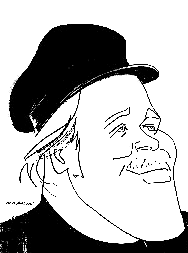
|
|
| Caricature of Glenn Loney by Sam Norkin. | |
Please click on "
* " to skip to each subject in this index:
Rebooting & Getting-Started for the NYC Arts Season 2007-2008: *
CURRENT IN NEW YORK MUSEUMS: *
At the Asia Society: *
THE ARTS OF KASHMIR *
ZHANG HUAN: ALTERED STATES *
PIRANESI AS DESIGNER *
PROVOKING MAGIC: LIGHTING OF INGO MAURER *
IDEO SELECTS: Works form the Permanent Collections *
National Design Awards 2007 *
At the Dahesh Museum: *
At the Frick Collection: *
Fragonard Re-Hung *
At the Galerie St. Etienne: *
LEONARD BASKIN: Proofs & Process *
At the Arnold & Marie Schwartz GalleryMet: *
GUILLERMO KUITCA: Stage Fright *
At the Guggenheim Museum: *
RICHARD PRINCE: Spiritual America *
Restoring the Guggenheim’s Frank Lloyd Wright-Infrastructure: *
At the Jewish Museum: *
CAMILLE PISSARRO: Impressions of City & Country *
ISAAC BASHEVIS SINGER & THE LOWER EAST SIDE: *
Photographs by Bruce Davidson *
At Madison Square Park: *
MAD. SQ. ART.2007: WILLIAM WEGMAN *
At the Metropolitan Museum of Art: *
ETERNAL ANCESTORS: The Art of the Central African Reliquary *
THE AGE OF REMBRANDT: *
Dutch Paintings in the Metropolitan Museum of Art *
IMPRESSED BY LIGHT: *
British Photographs from Paper Negatives, 1840-1860 *
ABSTRACT EXPRESSIONISM & OTHER MODERN WORKS: *
The Muriel Kallis Steinberg Newman Collection in the Metropolitan *
In the Met’s New Joyce & Robert Menschel Hall for Modern
Photography: *
DEPTH OF FIELD: Modern Photography at the Metropolitan *
At the Morgan Library & Museum: *
PAINTED WITH WORDS: Vincent van Gogh’s Letters to Émile
Bernard *
At MoMA/The Museum of Modern Art: *
PANORAMAS OF THE MOVING-IMAGE: *
Mechanical Slides & Dissolving View *
From 19th Century Magic-Lantern Shows *
ERNIE GEHR: Moving-Image Minimalist *
MoMA’s Single-Gallery FOCUS Exhibitions Continue: *
FOCUS: ELLSWORTH KELLY *
FOCUS: ALEXANDER CALDER *
At the Municipal Art Society: *
JANE JACOBS & THE FUTURE OF NEW YORK *
At the New York Public Library: *
GRAPHIC MODERNISM: From the Baltic to the Balkans, 1910-1935 *
At the Rubin Museum of Art: *
BON: The Magic Word *
BIG! Himalayan Art *
WUTIASHAN: Pilgrimage to Five-Peak Mountain *
At the Society of Illustrators: *
CUTTING EDGES: Cartoon Art Defining the World *
At the Whitney Museum of American Art: *
KARA WALKER: My Complement, My Enemy, My Oppressor, My Love *
Arts Beyond the Hudson: *
Exploring History & Artifacts in Madison, NJ: *
Rebooting & Getting-Started for the NYC Arts Season 2007-2008:
It has been a long hard summer for Your Scribe. During July & August—as has been his custom for many summers—he reported on major Performing Arts festivals, such as those at Bayreuth, Bregenz, Edinburgh, Munich, & Salzburg. In fact, this past summer was his 51st visit to these prestigious fests of Opera, Drama, & Dance.
Initially, way back in 1956, when he went off to EUCOM as a University of Maryland Overseas professor, he made a bee-line for Bayreuth & its historic Margräflisches-Opernhaus, designed by Galli-Bibiena, as well as for Richard Wagner’s famed Festspielhaus.
[EUCOM was code for the US Army’s European-Command: we were still an Army-of-Occupation in West Germany. In the Far East, the code-word was FECOM.]
As I had written a Thesis-report on Max Reinhardt at UC/Berkeley, I felt I also had to visit the Salzburg Festival, founded by Reinhardt & friends. Munich was a major center of University of Maryland classes, and I stumbled on Bregenz, passing through on a train, transfixed by the sight of an operetta-stage floating out in the waters of Lake Constance.
Having had not one, but two, Scots grandmothers, I discovered the Edinburgh Festival by default. In those long-gone days, the Dollar was King, so paying for festival-tickets—which were never sold-out, as so few tourists were around then—was painless.
At that time, I had no idea about Press-Offices & Press-Tickets. But I did notice, in reading the New York Herald-Tribune, the New York Times, & the Christian Science Monitor, that—in Cultural-Reportage, at least—Europe began with London & ended in Paris. This was as true for major Museum-Exhibitions as it was for theatre & opera-events.
So I began sending some unsolicited reports to the Herald-Trib, the Monitor, & the now-defunct Theatre Arts Monthly. Only in 1960, newly returned stateside & now teaching in New York—when I began my annual summer-safaris to European Festivals—did I discover the Miracle of Free-Seats for Critics!
In those days, I had three entire summer months to cover major & minor European Festivals, such as those in Holland, Aarhus, Stockholm, Copenhagen, Flanders, Chichester, Stratford, Avingnon, York, Vienna, & Verona. This was the time when a three-month-long Eurail-Pass cost only $300! Second-Class, of course.
Over the course of four years teaching in Europe, North Africa, & the Middle-East—Sa’udi Arabia!, I had made many friends, so there were always sofas, spare-beds, or carpets on which to lay my performance-pixilated weary head. I also became expert on sleeping in railway & bus-stations, as well as taking night-flights & overnight rail-journeys.
What I soon discovered, however, was that some envious stateside colleagues & credulous readers assumed I must be very wealthy to be able to afford three months of five-star hotels & dining at the Tour d’Argent. For the record, when I was teaching in Europe, I was paid $2,500 per year, plus free BOQ accommodations on Army & Air-Force bases.
And I have never had a meal at the Tour d’Argent, although Pierre Cardin once had booked a table there for our Espace-Cardin interview. As I had to record our conversation, I had to pass, because they do not permit recording-devices in the ratatouille…
Returned the US, I was paid $5,000 per year at Hofstra College on Long Island—now Hofstra University. When I moved to Brooklyn College, the pay improved, but not by much. So, over many summers, I learned how to travel & survive on very little.
I was thus also able to see & to report on some absolutely splendid opera, dance, & drama productions, as well as report on major Museum-Collections & special Arts-Installations.
In addition, I was often privileged to interview major directors, performers, playwrights, conductors, musicians, designers, & theatre-technicians. As well as architects, artists, & museum-curators! All of these interviews have been recently digitized & will soon be available online.
When my father & then my mother became aged & senile—no one knew about Alzheimer’s then—I had to reduce my three-month European-Summer to two. This I have now maintained for many years, but, as friends with sofas have passed-away, I have become dependent on inexpensive but friendly hotels & pensions.
Unfortunately, this past summer, almost the same itinerary as that for summer 2006, cost twice as much! European prices had gone up in the interim, of course, but the virtual doubling was owing to the precipitous fall of the Dollar against the Euro!
And the Dollar continues to fall. Americans who have not traveled outside the United States—and thus not been obliged to change their dollars for more stable currency—will not have noticed that this has happened. How & why it has happened is another story…
Your Scribe has never been paid travel-expenses by any of the publications for which he has written. As for non-paying academic-journals, you often even have to pay membership-dues so the organization can afford to publish its journal.
[Because being with my CUNY students for scheduled-classes was always most important for me—that is, after all, what I was paid-for & educated to do—I did miss some all-expenses-paid FAM Travel-Writer-Junkets, offered to me only at the last-minute, when the Editor could not go & I could not/would not find a Substitute. Thus I missed the press-opening of the Musée D’Orsay, with accommodations at the Hotel Georges Cinque!]
So, neither Paid nor Thanked for what he has written, Your Scribe is debating whether he can any longer afford to travel abroad to report & review on the Performing Arts & the European Art-Scene. An end-of-October Baltic-Theatre-Conference in St. Petersburg is thus out of the question.
The Curators Choice European-Reports which will soon follow this New York City filing could be the last of Your Scribe’s reports from abroad. Unless our President & our Congress can restore the Value & the Prestige of the US Dollar abroad…
Not only did Your Scribe see many remarkable—as well as some horrendous—Opera, Drama, & Dance productions this past summer—as well as some outstanding Museum & Gallery exhibitions—but he also snapped some 4,000 print-images, 700 slide-images, & 1,500 digital-images for his INFOTOGRAPHY™ photo-collection. The Trademark designation was finally awarded in late June!
All these archival-images need to be captioned, artfully-arranged in real & virtual albums, & computer-indexed—before I forget if this or that shot was taken in Prague or in Kloster Neuburg…
This is a lot of hard work—for which I am also neither Paid nor Thanked—but it has to be done, as there are now more than 300,000 INFOTOGRAPHY™ images, all of which will eventually be digitized & made available online at INFOTOGRAPHY.biz
As I am the Chief Correspondent for New York Museums/Curators Choice’s sister web-site, New York Theatre-Wire.com as well, there was, three days ago, an eight-inch-high stack of theatre-programs from September Openings of new shows in Manhattan. These have now been listed & at least summarized, with the filing of Show-Notes 2007.16.
This Curators Choice report will soon be followed by reports of major museum & gallery shows seen while on the Grand Tour of European Festivals. The photo-images on the PR CDs for some of these exhibitions are too good to file away without sharing them.
For these varied reasons, I want to clear-the-decks, so to speak, by surveying briefly the range of the new & current New York Museum & Gallery Exhibitions.
Perhaps—if I ever get caught-up on captioning & indexing INFOTOGRAPHY™ photo-images—I can return to my previous practice of giving each show a more detailed comment. --GLENN LONEY
[725 Park Avenue @70th Street/NY, NY 10021/Phone: 212-288-6400]
[Closing 6 January 2008]
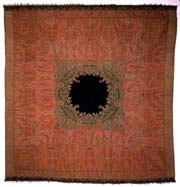 |
| Dragon shawl Kashmir Dogra period, 1860, Asia Society, New York. |
The Vale of Kashmir was once a Tourist-Must, both for its natural beauties & for its centuries-old arts & crafts. Today, sadly owing to local-insurgencies & territorial-tussles between two major Asian Nations, it is not the safest place to visit.
Fortunately, if New Yorkers cannot easily go to Kashmir, at least some of its remarkable arts-treasures have just come to Manhattan. There are some 130 of these precious objects on display at the Asia Society, representing the cream of Eastern & Western museum & private collections.
Because of Kashmir’s strategic location in the Himalyas, over the centuries its culture has been enriched by artworks & ritual-objects from Buddhist, Hindu, & Mughal-Muslim traditions. So there are some notable Buddhas on view, as well as ornamental-tiles, calligraphies, religious-paintings & cult-sculptures.
Most distinctive of Kashmir, however, are its intricately designed shawls & carpets, some impressive examples of which are now on display.
It’s an easy quip, but it is certainly not true that: "When you’ve seen one Buddha, you’ve seen them all." A visit to the Rubin Museum in Manhattan will also confirm their variety. Over the centuries, the Buddha has taken many forms, & the Bodhisattvas are notably varied.
With its Multiplicity of Gods, the Hindu Pantheon provided even greater inspiration for Kashmir-carvers!
Among the priceless relics are the 7th century limestone Dancing Mother-Goddess Indrani and a similarly-aged Kashmir Buddha of copper & silver-gilt.
At the press-preview of the exhibition, the difficulty of mounting such a show—especially borrowing treasures from Kashmiri Srinagar—was emphasized. The show itself cost more than a million-dollars to assemble, design, & install, while the insurance on the loaned-objects covers a valuation of over $7 million!
[Closing 20 January 2008]
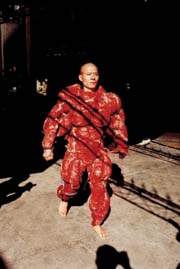 |
| My New
York, 2002 Color photograph of performance, Biennial Exhibition, Whitney
Museum of America Art, New York |
Quite a different-note is struck at the Asia Society with the Altered States show of Zhang Huan, whose exploits as a far-out Performance-Artist have to be represented in some stunning photographs. Zhang wearing a body-suit of raw red meat is one of the most arresting images.
Although he was born into a Maoist China which discouraged all forms of Individual-Expression, Zhang bided his time until after the student-uprising at Tiananmen Square. He began his career as a performance-artist in Beijing, initially performing feats of physical-endurance that "pushed the limits."
In 1998, he came to New York for its greater freedoms of artistic-expression, creating performance-works that often involved many volunteers. These are also captured in photographs at the Asia Society.
But he has since returned to China, based in Shanghai, where he has a large center of operations for creation of large-scale Installations, unusual paintings, & oddly impressive sculptures.
One of the most striking of the photo-series are three successive shots of Zhang’s fierce-face, painted over with Chinese ideographs, until only the eyes & ears are clearly visible as part of a living visage.
Interviewed at recent forum at the Society—where he was treated almost as a Cult-Oject—Zhang noted that he had to be very selfish as an artist to achieve what he had envisioned. So much for the Thought of Chairman Mao!
At the Cooper-Hewitt, the Smithsonian’s National Museum of Design:
[2 East 91st Street/NY, NY 10128/Phone: 212-849-8400]
[Closing 20 January 2008]
Not to be confused with the Italian composer, Pergolesi, the brilliant 18th Century Italian artist/architect Giovanni Battista Piranesi is best-remembered by art-lovers as the inventor of the fantastic & fearsome Carceri, or Imaginary-Prisons series of etchings.
But Piranesi is almost equally-famed for his remarkable Veduti di Roma series of etchings, in which he captured for all time the nostalgically-powerful appearance of Roman & Renaissance Antiquities, some long in ruins or stripped of statuary & ornament by amateur-collectors on The Grand Tour.
What many Piranesi-admirers do not realize is that he thought of himself more as an architect than a mere designer or printmaker. But only one of his architectural-projects was realized; however; the drawings he made for it are now on view at the Smithsonian-Cooper-Hewitt.
Greatly influenced by archeological excavations during the Enlightenment, Piranesi was interested in reclaiming the architectural Glories of Ancient Greece & Rome in what were, in his time, new buildings & interiors. So he made many fascinating designs for wall-decorations, furniture, candelebra, & other forms of ornament.
Not only sketches & published etchings of Piranesi’s designs are on view, but also actual objects—either copies from his designs, or inspired by them—in the work of Robert Adam & other notables of the 18th & 19th Centuries. Piranesi was, effectively, a fountain-head of Neo-Classicism.
But the Smithsonian-Cooper-Hewitt show goes even farther into Piranesi-inspired influences by demonstrating how his architectural & design ideas have influenced major modern architects, such as Daniel Libiskind, Michael Graves, Peter Eisenman, & Denise Scott Brown/Robert Venturi.
[Your Scribe owns one of the Piranesi Views of Rome series, the Cloaca Maxima, which he bought, oak-frame included—for only ten Deutsche-Marks in Munich half-a-century ago. It was a choice between the Temple of Vesta or the immense opening of the Great Sewer of Rome into the River Tiber.
[Poorly paid by the University of Maryland, my rule was never to spend more than $10 on a book or object from the Past. I chose the Cloaca—not for deep interest in Municipal Waste-Management in Antiquity—but because Piranesi’s vision of the great arch, the varied masts of boats on the river, & other design-felicities were-and-are so compelling.
[In the shabby Munich shop, I removed the large etching from its frame & returned the oak & glass to the Trödel-Handel’s dealer, who had no knowledge of Piranesi or the value of the images. He thought the frames were worth the ten Marks, not the old pictures.]
PROVOKING MAGIC: LIGHTING OF INGO MAURER
[Closing 27 January 2008]
The entire second-floor of the old Andrew Carnegie mansion—now the Smithsonian-Cooper-Hewitt—is ablaze with Light! But this is not generated from energy-saving low-amp fluorescent light-coils: the Ingo Maurer show is not about Green or Minimalist-Lighting.
For more than four decades, the Munich-based artist/technician has been adapting ordinary—and some not-so-ordinary—light-bulbs into Rube-Goldberg-like contraptions, remarkable light-sculptures, & fantasy light-objects such as the Flying Light-bulb, which has sprouted wings! Maurer calls these the Lucellinos.
Ingo Maurer has even created electronic LED wall-paper which comes in rolls you can glue onto your living-room walls & then watch the changing patterns of the myriads of tiny colored lights embedded in circuits in the sturdy paper.
In the current show, there are even special Art-Light-Installations, as well as a number of individual light-inspired objects & sculptures. Some are chandelier-like creations, less useful as illumination than awe-inspiring hanging collage-sculptures, glowing from the heart of their beings.
One of these is made of variously cracked white glass faces of a Chinese Laughing-God—Buddha in a Good Mood? Another chandelier features shards of white porcelain-plates, like an explosion in the china-closet…
Then there’s the Neon Table, the LED Benches & LED Wedding-costume, the Golden Ribbon, & the flower-like Mamo Nouchies!
These are not necessarily one-of-a-kind. Maurer & his associates invent, devise, & fabricate such wonders in his Munich-area workshops.
Maurer & his charming daughter were on hand for the opening. He is a delight in discussing how he gets such imaginatively outrageous ideas for using light to create art.
IDEO SELECTS: Works form the Permanent Collections
[Closing 20 January 2008]
IDEO is not another one of those one-name-only avant-garde artists. It is a Palo Alto-based firm—on the very edge of Silicon Valley—that employs more than 500 "design-thinkers" in seven offices on three continents to pursue the disciplines of design, engineering, social-science, & business-strategy.
Usually, the Smithsonian-Cooper-Hewitt invites an individual-artist to select hidden works from its crammed filing-cabinets, overflowing-shelves, & storage-vaults to put often surprising artworks on view, consistent with some kind of Theme.
For this peek into the S-C-H Archives, IDEO used three "lenses" for making its corporate-choices: INSPIRATION, EMPATHY, & INTUITION. How this Trinity impacts on IDEO’s own operations is implied in their choices.
Among the Chosen-Ones are Ladislav Sutnar’s Build the Town building-block set w/cars, Ettore Sottsass, Jr’s red Valentine portable-typewriter w/cover-box, & Chas & Ray Eames’ pressure-molded single-piece wood-laminate Child’s Chair.
Ornamental & Graphic Designs are also prominently featured. Just the kind of choices you’d expect from people whose HQ is virtually in the shadow of Stanford University’s Hoover Tower…
Winners in such categories as Design-Mind, Communication-Design, Product-Design, Landscape-Design, Interior-Design, & Fashion-Design are currently saluted at the Smithsonian’s Cooper-Hewitt. Among the winners are Chip Kidd, Rick Owens, Jonathan Ive, & Denise Scott Brown/Robert Venturi.
Adobe—you may have some of its software-programs on your computer!—won in the category of Corporate Achievement: what would the World do without Photoshop & Adobe-Acrobat?
[580 Madison Avenue/NY, NY 10022/Phone: 212-759-0606]
The Bad News is that the Dahesh Museum is giving up its Madison Avenue galleries in what was once called the IBM Building. The Good News is that it will not disperse its collections, while it looks for a new home, possibly beyond the costly shores of Manhattan Island.
If the Dahesh leaves New York entirely, this will be a great loss, not least for arts-researchers who will have less opportunity to study a wide range of the great Salon-Art of the 19th Century. The Metropolitan Museum of Art certainly has important canvases & sculptures by noted artists of the period, but most of these are usually in storage.
[1 East 70th Street/NY, NY 10021/Phone: 212-288-0700]
[Closing 16 September 2007]
By the time you read this, the major panels of Jean-Honoré Fragonard’s Progess of Love series will have ended their summer "run" in the East Gallery of the Frick Mansion/Museum. During the extensive refurbishment & relighting of the Fragonard Room—the first in 75 years!—the four major panels have been hung in a quite different conformation & under partly sky-lit illumination, giving viewers an opportunity to study them outside the rococo environment of the Fragonard Room, to which they were returned on the completion of the room’s restoration.
Acquired by Henry Clay Frick from the sale of JP Morgan’s treasures in 1915, the four panels depict: The Pursuit, The Meeting, The Lover Crowned, & Love Letters. In the East Gallery, they were joined by Fragonard’s Love Triumphant & Reverie, as well as some outstanding examples of period-furniture.
[24 West 57th Street/NY, NY 10019/Phone: 212-245-6734]
LEONARD BASKIN: Proofs & Process
[Closing 5 January 2008]
 |
| Black and Red Raptor, 1990,Leonard Baskin, Leonard Baskin: Proofs and Process, Galerie St.Etienne, New York. |
Usually, new shows at the Galerie St. Etienne focus on German & Austrian Expressionists, as well as other schools of Central European Artists & the occasional Naïve or Brut folk-artist or madman from abroad.
But the gallery’s founder, Otto Kallir, was also a major force in forming the reputation of Grandma Moses & marketing her naïve paintings of 19th Century American farm & village-life. His grand-daughter, Jane Kallir, has added the strange girl-obsessed drawings of Henry Darger to their artist-roster.
Now she is focusing on the varied career of Leonard Baskin, who was famed as an artist in wood-cuts, as well as a notable print-maker & arts-book-publisher. But he was also a gifted sculptor & painter, so the intimate spaces of the Galerie have had to provide wall & floor-space for 12 monotypes, 20 etchings, woodcuts, & lithographs. As well as eight small bronzes & one wood-sculpture: Sibyl with Birds. Plus 14 watercolors & drawings.
Baskin’s opposition to War, his yearning for Peace are celebrated: satirically in Dulce et Decorum est pro Patria mori: "It is sweet & beautiful to die for one’s country."
His fascination with Birds, especially with Raptors like Owls & Eagles, is also notably on view. Almost as interesting as this exhibition is Jane Kallir’s catalogue/brochure essay on Baskin’s life, influences, & achievements.
Although necessarily brief, these insightful essays for each Galerie show are worth publishing in a collection, for they are not only thoroughly grounded in research, but they are also eminently readable & informative.
At the Arnold & Marie Schwartz GalleryMet:
[Metropolitan Opera/Lincoln Center/NY, NY 100/Phone: 212-870-7441]
GUILLERMO KUITCA: Stage Fright
[Closing 1 November 2007]
Thanks to the complete Overhaul of Programs & Productions at the Met Opera, under its new Artistic-Director, Peter Gelb, the Met now has a Lincoln Center Plaza-level art-gallery, to complement its various opera-themed exhibitions inside the house.
This usually unused-space was formerly the box-offices for ballet-performances, to distinguish it from the opera-performance box-offices on the opposite side of the entrance-foyer. It is small, but welcome.
The initial show is a series of colorful—if potentially terrifying—Deconstructions of Met Opera Schematic Seating-Plans, plus some unsettling images of an imagined Flying Dutchman production. This work is in the collection of the Museum of Modern Art, no less!
Stage Fright is an apt title for Guillermo Kuitca’s inaugural exhibition. Using the Miracle of Digital-Imaging, Kuitca has been able to distort & disintegrate—even visually melt—various versions of the Met’s auditorium-seating.
This is, of course, pure Speculative-Fantasy. But what if Jihadist Suicide-Bombing Enemies-of-Freedom decided to Take-Out the Met? With a Capacity-Audience smugly seated in it?
The Prophet—Blessed be His Name—was firmly opposed to representations of Human-Beings & even Animals, following the Ancient Rule against the making of Graven-Images, enshrined in the Ten Commandments. So also have the Super-Orthodox been opposed to stage-representations…
The Cairo Opera-House—created for Verdi’s Aida, celebrating the opening of the Suez Canal—was a tremendous offense to pious Muslims. In fact, it mysteriously burned down shortly after I photographed it in the late 1950s. It has since been replaced with a handsome new opera, but there are armed-guards everywhere in Cairo now…
[1071 Fifth Avenue @89th Street/NY, NY 10128/Phone: 212-423-3500]
RICHARD PRINCE: Spiritual America
[Closing 9 January 2008]
For some collectors of Contemporary American Art, Richard Prince’s varied works are Must-Haves, not least because he has made it his business to appropriate actual images—photographic & otherwise—from popular & commercial sources & other artworks.
On the other hand, however, there are other collectors & critics who are either ambivalent or angry about his use of such popular advertising-imagery as the photos of the Marlboro Man. For some, such usage is just this side of Visual-Plagiarism.
Then there are those critics who think this shows a poverty of imagination, or even more crass-motives, in tapping into the Consumer-clichéd Mainstream. But this has its distinct marketing-advantages with rich, aesthetics-challenged, would-be art-collectors who can easily relate to the painted detritus of our Popular Culture, presented in Museum-Quality frames. Or much more often, totally without frames: just stretched-canvases.
The Guggenheim’s "take" on Prince’s varied creations is that, in sum, they provide a kind of commentary on American Spiritual Essences. If that has really been his Plan from the beginnings of his career, he clearly has not found much to admire—and very little that could be called remotely "Spiritual."
Appropriated fashion & ad photos range from the glossy to the washed-out. Canvases lettered with stale old sex-jokes, repeated over & over, counterbalance a series of roughly-realized ink-jet prints on canvas with acrylic, which include such masked-women as Debutante Nurse & Nurse of Greenmeadow.
There are also strewn-about mock-ups of auto-bodies & large fragments thereof, painted in dull grays, blues, & pinks.
According to the prevalent Curatorial Wisdom, Richard Prince’s works’ iconographies "register prevalent themes in our social-landscape, including a fascination with rebellion, an obsession with fame, & a preoccupation with the tawdry & the illicit."
Well, if that is what Sells, so be it…
Restoring the Guggenheim’s Frank Lloyd Wright-Infrastructure:
When Frank Lloyd Wright originally designed the Guggenheim Museum, he was consciously "pushing-the-envelope" of what was structurally-possible in construction. Unfortunately, some of the materials & methods used were not adequate to what was needed over the years.
Over the past fifty-years, various interventions have been made, especially to patch or conceal cracks in the building’s exterior. In the current on-going restoration & preservation of the Landmark structure, no less than eleven coats of paint have been removed!
Although Wright’s radical design for the rotunda has been found "irreproachable" by the architects & engineers working on the project, it had some initial technical & material shortcomings which are being corrected in the restoration.
An excellent report on the nature of this work—& the people & firms responsible—was recently posted on the Internet, but Your Scribe is unable to paste that into this posting. Fortunately, the Women Who Know—Eleanor Goldhar & Betsy Ennis—can be contacted e-mail: publicaffairs@guggenheim.org.
But they are surely very busy, so you might find the report instead on the museum’s website: www.guggenheim.org. You will surely learn something about construction with nozzle-sprayed Gunite that you did not know before.
[1109 Fifth Avenue @92nd Street/NY, NY 10128/Phone: 212-423-3200]
CAMILLE PISSARRO: Impressions of City & Country
[Closing 3 February 2008]
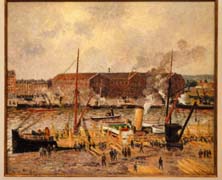 |
| Camille Pissarro, The Wharves, Saint-Sever, Rouen, 1896, Jewish Museum, New York. |
Camille Pissarro was the only one of the French Impressionists who was Jewish. Thus he has already had an impressive exhibition at the Jewish Museum, though it is surely his genius & powers as an artist that has recommended him for two major shows at this handsome Landmark Neo-Gothic Mansion-Museum.
[Your Scribe especially remembers the previous survey of Pissarro paintings for a haunting view of Rouen at sunset, not least because it was loaned to the Museum by a former grad-student!]
The current show offers nearly 50 Pissarro paintings & works-on-paper, most of them from private-collections in the New York area. The focus is not only on his city-views of Paris, Rouen, & London & more pastoral scenes beyond the metropolis, but also on his theories about painting such realities & the social-beliefs that informed his choices of subject & his way of viewing them.
His attitudes were Egalitarian, inflected by Anarchist writings, but he stressed Nature & Sensation in his paintings. Not shocking-sensationalism, but rather shifting feelings, memories, & perceptions of people & the world in which he lived.
ISAAC BASHEVIS SINGER & THE LOWER EAST SIDE:
[Closing 3 February 2008]
The Lower East Side—especially as the beloved Yiddish writer, Isaac Bashevis Singer knew it & chronicled it—has virtually disappeared, swallowed up in Trendiness & Development. So it was a Good Thing that photographer Bruce Richardson made several suites of black & white photograph of it & its denizens before the Past was swept away.
Richardson was an artist-neighbor & friend of Singer’s, both of them living on the Upper West Side, rather than on Delancey Street. Initially photographing Singer at work & at home, Davidson followed him downtown to the Garden Cafeteria, where he was able to lens Singer & his East-European immigrant-friends, some of them Holocaust-Survivors.
 |
| Bruce Davidson, Woman in front of the Garden Cafeteria, 1973, Jewish Museum, New York. |
These images of homely Menshlichkeit are reminders of how varied life once was in the less-upscale neighborhoods of New York, especially for poor folks whose major affinity was their Jewish culture & faith, rather than their relative poverty.
Singer provided Richardson with the necessary metaphoric-key to making a photo-opening into this world. To cynical viewers, some of the people captured in these photos may seem almost ridiculous, but their expressions often reveal their pleasure at sharing their immediate moods for Richardson’s lens.
The photos are accompanied by informative wall-texts, even though it is said that "one picture is worth a thousand words." But that saying referred to Chinese words, not to Yiddish!
[Madison Square Park, @East 23rd Street, between Madison & Broadway]
MAD. SQ. ART.2007: WILLIAM WEGMAN
[Closing 28 October 2007]
Do not expect to see either William Wegman or one of his handsome & ubiquitous Weimariner dogs live when you get off the Fifth Avenue bus down on 23rd Street. The current Wegman Weimariner art-show is rather smaller-scale than the nearby Madison Square Park exhibition of Silver Trees of Roxy Paine.
Near the very popular Shake-Shack—ringing a tiny parklet beside a forest of snack-tables & chairs—are four Plasma-TV Monitors on which are shown loops of Wegman’s famous dogs, dressed in casual clothes, one even in a curly blonde-wig!
What is especially unusual about these elegant hounds is that their necks & heads poke out of clothing that is animated by human hands & legs! The effect is both amusing & unsettling…
Roxy Paine’s silver tree-trunks all have names: Conjoined, Defunct, & Erratic. Wegman’s un-named dogs sometimes seem Erratic & they are obviously Conjoined with humans, but they are definitely not Defunct.
At the Metropolitan Museum of Art:
[1000 Fifth Avenue @82nd Street/NY, NY 10028/Phone: 212-535-7710]
ETERNAL ANCESTORS: The Art of the Central African Reliquary
[Closing 2 March 2008]
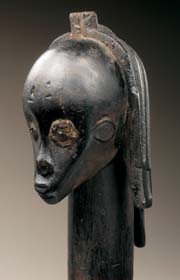 |
Sculptural Element from a Reliquary Ensemble: Head Fang peoples, Betsi
group; Gabon 19th century Wood, metal 2664, Metropolitan Museum of Art,
New York. |
Just as the beautiful Bronzes of Benin—created as religious cult-objects of devotion—came to be admired & collected in the West as powerful works-of-art, so also did the Ancestor-Reliquaries of the Tribes of the Central-African Equatorial Forest.
Currently at the Met, some 130 varied & arresting examples of such artful Ancestor-Worship totems are on display. Often containing some bone, hair, or other token of one or more ancestors, such reliquaries were used to invoke favors from the Gods on both tribe & individuals. In fact, they are still in use in many obscure villages & forest-temples.
Perhaps to allay clichéd-reactions of unsophisticated museum-visitors—"Can you imagine! Worshipping something as peculiar as that?"—the first chamber of this extensive show offers impressive examples of both Western & Asian Religious-Reliquaries that are also unquestionably High-Art.
Here is a gleaming Silver Severed-Head of a Roman-Catholic Saint! Next to it is a jeweled Silver Arm-case for another Holy-Relic. ["What could be as fine as/The thigh-bone of St. Thomas Aquinas?"]
Then there are all those Buddhist Stupas in Thailand, Cambodia, Tibet, & Myanmar/Burma. Each is supposed to contain some relic of the Buddha—who would have to have been immense in life, to provide so many bone-fragments & toe-nail clippings. A Stupa-photo is on view in this show…
[But then, if all the fragments of the True-Cross were re-assembled—as Mark Twain once noted—you could build houses for ten-thousand families.]
Your Scribe has spent some time in African Museums & has also visited village-shrines. Never have I seen such a profusion of African reliquary cult-objects as is now being displayed at the Met. None of them has been robbed from a Native-Shrine. At least, not for this exhibition, as many come from important Western-Collections.
Nonetheless, considering the tremendous Religious-Significance of such objects to families & tribes in the Cameroons, Gabon, Guinea, & the Congo, how these strange, even haunting, sculptures now on display initially came West raises some questions. Some, of course, were seized as booty in inter-tribal warfare: "You lost the war, so your gods & ancestors have no power over us. Those of you we do not slaughter, we will enslave!"
[My rule always was, when offered images by Native-Traders: Do not buy a wooden-image of a man or woman studded with spikes & sharp shards of glass! You cannot know what Ancient Curses you may be bringing into your home…]
Fortunately, such Western artists as Pablo Picasso, Maurice de Vlaminck, André Derain, Henri Matisse, & Sir Jacob Epstein had so such fears. And so it is that some of their own collectibles are in this show. The Fang image, known simply as Female Figure, was once owned by Derain, then by Epstein, & now by the Met.
Also on view is the famed "Black Venus." Nowhere in Africa will you see such a large & varied collection of African Ancestor-Reliquaries as are now on display at the Metropolitan.
Dutch Paintings in the Metropolitan Museum of Art
[Closing 6 January 2008]
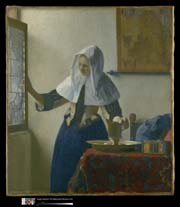 |
| Johannes Vermeer,Young Woman with a Water Pitcher,ca. 1662, Metropolitan Museum of Art, New york. |
Seldom have so many Dutch/Flemish Masterpieces have been on view at the Met. You might see more in The Hague or in Amsterdam’s Rijksmuseum, but the 228 works now hanging on the walls represent the Met Museum’s entire collection of Dutch paintings of the so-called Age of Rembrandt!
All this bounty is by way of celebrating Rembrandt’s 400th Anniversary! It is also safer & cheaper than having to borrow Rembrandts & Ruysdaels from London & Amsterdam.
It is almost a cliché—but also a truth—that most great museums seldom have more than ten-percent of their actual holdings on view at any one time. So this is perhaps the last time you will ever be able to survey the major & minor paintings of both major & minor Flemish Talents—many usually stored in the bowels of the Met.
When the Met acquired Rembrandt’s Aristotle Contemplating a Bust of Homer, its prodigious Purchase-Price was almost Bigger-News than the actuality of being able to share such a great artwork with a very wide public. [There were those who thought the money would have been better-spent on low-income-housing…]
The Met’s Rembrandt Self-Portrait of 1660—he was one of his own favorite-subjects, as he did not have to pay the model—is also on display, along with 18 others owned by the Met Museum.
Frans Hals is well-represented by eleven canvases, including his charming The Smoker & Merrymakers at Shrovetide. There are also a number of Hals’ noble, but severe, portraits of wealthy & worthy ruff-necked Dutch men & women. To see more, you would have to go to the Hals Museum in Haarlem, in the Nederlands.
The Met owns five of the 35 known Vermeers—which were recently shown together for what was surely the last time, considering stratospheric exhibition-insurance-costs & fears of International-Terrorism. You many not have another opportunity in the near future to see even all five of the Met’s Vermeers together!
Vermeer’s Woman with a Lute, Study of a Young Woman, & Young Woman with a Water Pitcher are almost reason enough to rush off to the Met for this showl
Cloud-spattered Dutch landscapes, notably those of Salomon van Ruysdael, are on view in force. If you come from Rural-Beginnings, you should savor paintings of cows & other farm-animals, Children & a Cow or Young Herdsman with a Cow, for instance.
But what show of Dutch Painting would be complete without at least one view of the interior of Delft’s Oude Kerk? Here is one by Hendrick Cornelisz van Vliet & yet another by Emanuel de Witte!
As contemporary tourists in the Netherlands can attest—matching such paintings with the actual interiors of such churches, in Delft, Dordrecht, Utrecht, Leyden, Haarlem, Rotterdam, & Amsterdam—nothing seems to have changed over the centuries! [Having distant-cousins in both Dordrecht & Delft, Your Scribe has photographed most of these ancient Dutch church-interiors for INFOTOGRAPHY™.]
It’s of interest that the core of the initial Metropolitan Museum’s collections was the "1871 Purchase" of some 174 Dutch paintings, not all of them Old Masters. In the current show, the entire Met Dutch holdings are hung in order of acquisition!
Thus, the exhibition-entrance is dominated by large portraits donated by Old New York Names. Among the rich & famous Names who have given Dutch-Masters to the Met are such Patronymics as Vanderbilt, Morgan, Bache, Havemeyer, Huntington, Marquand, Lehman, & Altman.
This extensive exhibition is spread over no less than 12 Met galleries!
British Photographs from Paper Negatives, 1840-1860
[Closing 31 December 2007]
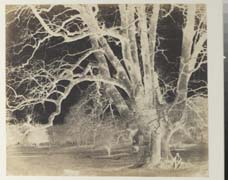 |
| Spreading Oak with Seated Figure, 1850s,The Metropolitan Museum of Art, New York. |
There is nothing like stark bare branches of a Great Tree—especially in winter-snows—to provide a photographer with an equally striking subject. But even more haunting is the negative-reversal of such a powerful image.
When such images are preserved on Paper-Negatives, they can be even more majestic, even ghostly. You can now see some excellent examples in the Met’s Howard Gilman Gallery & related spaces.
Many of these—originally created to make positive-prints for Family-Albums or for friends—have seldom been in public-exhibitions. Both paper-negs & positive pix are shown at the Met.
Fox-Talbot—William Henry Fox-Talbot, the British photography-pioneer—developed what he called the Calotype, made available to the public in 1841. This was followed, a decade later, by the glass-plate negative.
Although the glass-plates provided much sharper images & contrasts, they were difficult to prepare & use on-site, with a constant danger of breakage. Think of Matthew Brady with a bulky, heavy camera & wet glass-plates at Bull Run or Gettysburg…
Thus, the improved technology did not immediately sweep away the paper-image. It was especially useful for British tourist-photographers on the Grand Tour in Europe, or in the sands of Egypt, or the plains of India.
The 1851 Great Exhibition in London’s Crystal Palace gave the wider public its first opportunity to see what such early lensmen as Fox-Talbot, David Octavius Hill, & Robert Adamson had wrought. [Your Scribe has photographed the Monument of David Octavius Hill in an historic Edinburgh Cemetery, for INFOTOGRAPHY™.]
Popular subjects for early paper-negative enthusiasts were, of course, family & friends & home-scenes. But bare-branched ancient-oaks, ruined abbeys & castles, landscapes, farm-life & cottages, ships & seascapes also proved inviting.
Many of these surviving English & Scottish views suggest the nostalgic photographers’ longing for a rapidly vanishing Bucolic Past, already being swallowed-up in the Industrial Revolution.
Not only famed European-Sites attracted, but also the more exotic scenes of British-India.
Individual prints of the varied subjects are on view in this show, as well as large albums of images. Not to overlook examples of the cameras & technology: Paper-Negatives were created by coating fine writing-paper with chemical-solutions, drying them, & exposing them in a camera. Multiple positives could then be printed!
ABSTRACT EXPRESSIONISM & OTHER MODERN WORKS:
The Muriel Kallis Steinberg Newman Collection in the Metropolitan
[Closing 3 February 2008]
Muriel Kallis Steinberg Newman is described by Met Museum mavens as "one of the most prescient & astute collectors of the mid-20th Century." And why not?
After all, she not only gave the Met her entire collection in 2006, but she had the good fortune to be married to art-loving men who could collaborate with her on collecting & check-writing.
From the size of some of these canvases, it’s also clear that she had to have an apartment with enough wall-space to hang these disparate works. That also requires a fat check-book…
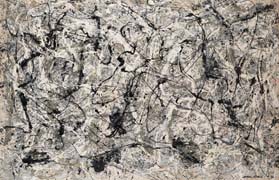 |
| Jackson Pollock (American, 1912–1956) Number 28, 1950, 1950, The Metropolitan Museum of Art, New York. |
Steinberg-Newman may not have "discovered" such Abstract & Otherwise-Disposed Talents as Jackson Pollock, Willem de Kooning, Franz Kline, Clyfford Still, Max Ernst, Jean Arp, Alberto Giacometti, Joan Miró, Claes Oldenburg, Kenneth Noland, Morris Louis, Sandy Calder, Joseph Cornell, Helen Frankenthaler, Arshile Gorky, Kurt Schwitters, Larry Rivers, David Smith, John Marin, Jacques Lipchitz, Fernand Léger, Hans Hofmann, Philip Guston, Arthur Dove, Matta, Robert Motherwell, & Mark Rothko, but she certainly recognized their widely-varied Artist-Visions.
You could found a small Museum of Modern Art with such a wide-ranging collection!
It is, however, necessary to note that Muriel Newman was not just a rich lady with Very Good Taste. She was, in fact, a highly trained & talented artist in her own right, becoming known for her portraits.
It would be interesting to keep her entire Collection together, perhaps as an Indicator of mid-20th Century Taste & Patronage—somewhat in the manner of the Jack & Belle Linsky galleries. But the Linsky Treasures are more homogenous in their periods, styles, & subjects.
Most Curators—following such a handsome Salute to a Donor—would want to integrate the various artworks into the Permanent Collections, according to their styles & possibly even nationalities. Would you put Matta next to Pollock? Or Ernst beside Oldenburg?
[Some years ago, the Los Angeles County Museum’s central-core resembled a series of opened Pharaonic Tomb-Chambers, minus the Mummies. It must have been an Official-Condition of Collection-Donation that each of the Rich-Angeleno Wife & Husband donors had to have a separate room in which to display their Wealth, Social-Visibilty, & Taste.
[Thus, you might find an Art-Deco Erté figurine reposing on a Louis Quinze table, with a small Pollock on the wall behind it. Possibly also with a John LaFarge glass fire-screen standing in front of an Adam Mantlepiece!
[Each room was also prominently marked with the Famous-Names—famous in LA, at least—of the Collection-Donors.
[Eventually, this form of Ostentatious-Display was Deconstructed, with artworks & objects-d’art being dispersed into museum-galleries, organized by period, style, school, or whatever…]
In the Met’s New Joyce & Robert Menschel Hall for Modern Photography:
DEPTH OF FIELD: Modern Photography at the Metropolitan
[Closing 23 March 2008]
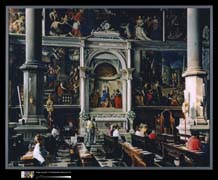 |
| Thomas Struth (German, born 1954), San Zaccaria, Venice, 1995, Metropolitan Museum of Art, New York. |
It has taken a while—a good long while—for Photography to be recognized as an important Art-Form, worthy of museum collecting & display. Manhattan’s Museum of Modern Art was certainly an American-Leader in this movement.
Because of the visual-power of black-&-white photo-images—as opposed, say, to Sepia-prints—they have long been favored as exemplars of Art-Photography.
But with the gradual incursion & erosion by color films into the Primacy of B&W, chromatic-color has been gaining-ground.
Nonetheless, some major-photographers still prefer the starkness of black-&-white photo-images, especially when capturing intense moments of Human Misery, or the feckless lives of Rednecks & Trailer-Trash.
Among the Problems with Color, however, are the fact that its varied hues often rob a complex-image of a visual-center that white or black could emphasize. Not only are individual colors in the visible-spectrum competing with each other in a color-image, but some colors are necessarily more powerful—not to mention emotionally-charged—than others, even at the same degree of Intensity.
Now you can explore some of these Color vs. B&W questions for yourself in the Met’s new Menschel Hall for Modern Photography. Museum-releases add "Contemporary" to the identifying-title, possibly to distinguish fairly recent images from Cartier-Bresson Classics.
But no, Henri doesn’t even make the Modern-cut, as no photos made before 1960 will be hung on these pristine walls!
Instead, you will see works by the Big-Names—some of them inflated & over-rated: Thomas Struth, Andreas Gursky, Jeff Wall, Sigmar Polke, Doug Aitken, Richard Prince, & of course the ubiquitous Cindy Sherman—also on view in Berlin, in the Martin-Gropius-Bau!
All these names are represented by photos—most of them large-scale—in the Met Museum’s Permanent-Collections, just in case you were worried that only the Guggenheim, the Whitney, & the Museum of Modern Art recognised their genius. Not to overlook the Water-Tower Obsessions of Germany’s Bernd & Hilla Becher!
At the Morgan Library & Museum:
[225 Madison Avenue @36th Street/NY, NY 10016/Phone: 212-685-0008]
PAINTED WITH WORDS: Vincent van Gogh’s Letters to Émile Bernard
[Closing 6 January 2008]
 |
| VINCENT VAN GOGH, letter to Émile Bernard, Arles, March 1888, Thaw Collection, The Morgan Library & Museum, New York. |
If you thought you really knew & understood Vincent van Gogh from reading Irving Stone’s Lust for Life—or from seeing Kirk Douglas cut off his ear in the movie-version—you will be totally surprised to discover the sensitive & sensible Vincent who emerges in the pages of his letters to his young friend, the novice-painter & author, Émile Bernard.
There are twenty of the known twenty-two Van Gogh letters on view at the Morgan, along with some important Van Gogh works & some less-important paintings by the young Bernard, to illuminate some of the points made in the letters.
Vincent was a friendly, but unsparing, critic of Bernard’s choice & execution of subjects. But his advice—both on painting & living—is both interesting & straight-forward. What is especially notable is his inclusion of bold ink-sketches of now famed paintings he was working-on or planning. He has even inked-in the names of the colors he is using, or will use, on various areas of the pictures!
Dedicated Van Gogh collectors would probably kill to own just one of those letters. There is very little Van Gogh material out there, unaccounted for… None of Bernard’s letters to Vincent have survived.
As the gallery—the former Morgan Library reading-room—is rather small, and the crowds may be considerable, you may want to buy the handsome catalogue in order to read the letters in English-translation at your leisure.
At MoMA/The Museum of Modern Art:
[11 West 53rd Street/NY, NY 10019/Phone: 212-708-9400]
PANORAMAS OF THE MOVING-IMAGE:
Mechanical Slides & Dissolving View
From 19th Century Magic-Lantern Shows
[Closing 25 February 2008]
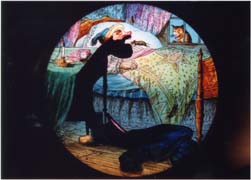 |
| Ernie Gehr, The Rat Eater (2006), Panoramas of the Moving Image: Mechanical Slides and Dissolving Views from Nineteenth-Century Magic Lantern Show, The Museum of Modern Art, New York. |
Many years ago, Your Scribe found a cache of large hand-colored Alice-in-Wonderland lantern-slides in a ratty old box under a sidewalk counter in Notting Hill Gate’s Portobello Road. I had always planned to mount these in a big wall-hung Light-Box, making them a living-room conversation-centerpiece.
Now, I don’t have to do that, as I can go over to MoMA—until late February—and see some even more wonderful lantern-slides mounted in light-boxes on MoMA’s walls! These actually are reproduced from the collections of the avant-garde Magic-Lantern-inspired artist, Ernie Gehr.
But they are not like my Alice-slides, which just sit there, waiting for the next slide in the narrative-series to be shoved behind the projector’s lens. Some of them have levers or screw-handles on their sides which permit arms, legs, & even eyes of the comic figures to move. Some characters can revolve; other figures can transform into different images.
Just as I had found Alice—& also some lever-operated slides—in London, so had Gehr found some of his greatest treasures in dusty old second-hand shops in California! But even before that, he had been fascinated by the idea of colored images, projected by the 19th Century Magic-Lantern. [These were also the earliest visual-impact on the theatre & film career of the late Ingmar Bergman.]
Even before Thomas Alva Edison discovered—or at least improved on the light-bulb—Magic-Lanterns were powered by candles, oil-lamps, or gas-flames. In fact, such image-projections go back as far as the 16th Century!
And even before Edison perfected the motion-picture camera, there had been successful attempts to create the impression of moving-images with the Zoetrope.
Using the sensation of the Persistence-of-Vision—which is why still-images still seem to move in movies—Zoetrope strips provided the effect of a figure in motion, with a printed series of silhouettes of a figure in various successive stages-of-motion on a paper-strip, punctuated between images with vertical-slits.
Installed inside a revolving metal-drum—mounted on a wooden pedestal—the paper-strip was adjusted to the matching vertical-slits cut into the drum. When the drum was spun rapidly & one peeked through what seemed to be the front-slit, the sense of motion was achieved.
Yes, there are Zoetrope strips on view at MoMA. If you are handy with your hands, you could even make one yourself! Among the Zoetrope’s fans are both Ernie Gehr & Francis Ford Coppola, who even named his film-production company after that amazing device!
Add also the names of PIXAR’s John Lassiter & his colleagues. They recently presented a Giant Zoetrope at MoMA, in the same space now devoted to Ernie Gehr’s collections!
ERNIE GEHR: Moving-Image Minimalist
[Closing 25 February 2008]
Inspired in part by these early attempts at simulating the effect of moving-images—whether seen through slits or projected & enlarged on a screen, Ernie Gehr has made a considerable reputation by creating highly imaginative films such as Glider, Serene Velocity, The Astronomer’s Dream, Cinematic Fertilizer, Before the Olympics, & Essex Street Market.
These films are shown at various times in MoMA’s Roy & Niuta Titus Theatres. Check the MoMA website for schedules of showings:
MoMA’s Single-Gallery FOCUS Exhibitions Continue:
[Closing 7 January 2008]
Focus is an interesting new program at MoMA, designed to focus on one artist, often rescuing some of his or her canvases or sculptures from Permanent-Collection basement-storage. These are usually limited to one room of the museum—which can have the unintended effect of permitting viewers to see even more powerful paintings in adjoining rooms. But not by the Artist-in-Focus.
Fortunately for Ellsworth Kelly, the long, non-figurative canvas in the next room was not nearly as arresting as his own distinctive design-images. Almost more interesting than Kelly’s actual canvases were his explanations of how they came to be, especially some very special Inspirations! It was very instructive to have him on hand explain his works, canvas-by-canvas.
It must certainly be immensely gratifying to know that famous avant-garde artists admire your work. So often, an Original Talent will be the target of envy, rather than praise.
Dominating the show, at least in terms of wall-space & simplicity, is Three Panels: Orange, Dark Gray, Green [1986]. Colors for a Large Wall is a checkerboard of orchestrated color-blocks.
His Vertical Line is exactly that. Kelly’s Vertical Lines are closely-spaced, whereas Grid Lines form an incomplete checkerboard, perhaps waiting for the blocks of color noted above?
Kelly’s Brooklyn Bridge VII is informed by an elegant & elemental simplicity of design that makes a Stella vision of the Great Neo-Gothic Bridge seem unduly complicated.
[Closing 18 February 2008]
For Cosmic Reasons, Sandy Calder was not able to explain his charming Mobile & Stabile works to the Press at his Focus preview. Fortunately, he was well-represented by his curator, Anne Umland.
While you can get a rather cynical view of Calder’s Art & Persona—notably his Circus, in an Upper East Side personal-presentation—from Thomas Wolfe, in You Can’t Go Home Again, his works should be able to speak for themselves.
If you Don’t-Get-It when looking at his wire-sculpture of Josephine Baker—or his Mobile titled Spider—wall-texts are not going to be much help. As for the wonderfully abstract A Universe or Constellation with Red Object, your own insights would probably be nearly as valid as those of, say, Charlie Rose.
[457 Madison Avenue/NY, NY 10022/Phone: 212-935-3960]
JANE JACOBS & THE FUTURE OF NEW YORK
[Closing 5 January 2008]
This very effectively designed Jane Jacobs Memorial-Tribute show is broken-up into three-dimensional themed-units, which permit groups to tour & study it, without all clumping around a central focus-point.
It not only surveys Jane Jacobs’ own important & influential New York career as a socio-environmental Municipal-Conscience & occasional Public-Scold, but it also looks forward into the city’s Future, using some of her concepts of Neighborhood, Landmarking, & Renewal as points-of-reference.
There is ample informational wall-text, as well as archival-photos & videos dealing with NYC Past & Present. Some of the sections are clearly designed to inspire viewers’ thoughts about what is now In-Progress in the city.
There are also several useful brochures, as well as Walking-Tours & a number of special programs, such as When the Big Get Bigger: New York’s Universities & Their Neighbors, Forest Hills: Garden City in the City, & Brooklyn Heights: America’s First Suburb.
One wall-panel shows a Diane Arbus photo of Jacobs & her son, Ned, in a Village habitat. This was taken shortly before Jacobs abandoned New York & the United States for Canada, to prevent her two boys from being drafted into the Vietnam War-Disaster.
This is certainly an aspect of Jane Jacobs’ Clarity of Vision that has seldom been cited. Jane Jacobs loved New York City, but she loved her sons more & wanted them to stay alive & unmutilated… [Of course, this has not been a problem for Geo. W. Bush & his twins.]
At the New York Public Library:
[5th Avenue @42nd Street/NY, NY 10018/Phone: 212-869-8089]
GRAPHIC MODERNISM: From the Baltic to the Balkans, 1910-1935
[Closing 27 January 2008]
 |
| Serving
tea and coffee aboard ship, designed by Karel Teige.
Prague, 1928. The New York Public Library, Slavic and Baltic Division,
New York. |
With the current cinema-run of the film-documentary on the evolution of the sans-serif typeface Helvetica, interest has been aroused in the development of 20th Century Modernist graphic-design & type-fonts.
But even before critics were discussing Art Deco design & typefaces, there were already very modern types & graphic-designs in Eastern Europe, from the Baltic Republics all the way down to Bulgaria! Examples of these in books, brochures, & posters are the focus of the new Graphic Modernism exhibition at the New York Public Library.
Most were clearly inspired by Soviet artists & designers’ experiments in Constructivism & Suprematism. But the Balto-Balkan designers have not received the attention given to major Russian talents. This show should help to correct that.
El Lissitsky & Hungary’s Laszlo Moholy-Nagy are of the few who achieved an International-Reputation. Otherwise, have you often heard of the work of Sirak Skitnik, Jerezy Hulewicz, or Jaan Vahrta? Victor Brauner, perhaps…
But this show of some 50 items is sited in a rather small, dark chamber, so its range is limited, as is the visibility of the objects. Oddly enough, the stunning full-color catalogue for the exhibition seems to have even more visual-material than the actual show.
Not only is it an outstanding contemporary example of what the earlier artists were trying to achieve with their own modern illustrations, bold-colors, striking sans-serif type-faces, & streamlined-layouts, but it is also more easily accessible than the exhibition.
When all the NYPL’s early 20th Century graphic artifacts have gone back into the fire-proof stacks, acid-free folders, & water-proof file-drawers, purchasers of the catalogue will continue to have a Permanent Reference on hand!
[150 West 17th Street/NY, NY 10011/Phone: 212-620-5000]
[Closing 14 January 2008]
Although Buddhism may have replaced various older religious Belief-Systems as it spread east from India into China & north into the Himalayas, it did not entirely displace the Bon religion of this culture-group still living in the Himalayas & Central Asia.
Instead, Bon incorporated Buddhist imagery & narratives into its own primordial beliefs in the natural spirits which dwell in special sites, in rocks, rivers, & trees.
Before Buddhism overwhelmed Tibet, Bon was the religion of most Tibetans. It is still practiced there by certain tribes, as well as by the Naxi in China & the Kinnauri of Northern India.
Despite the extensive Bon writings—some dating back a thousand years—as well as the precepts of its essential founder, Tonpa Shenrab, Bon is still little-known in the West. From the Holy-Texts: "The truthful Bon, the magic word that makes the fool eloquent."
Even less known than the actual Bon doctrines are the many Bon artworks & cult-objects from the Himalayas & other areas of Bon-believers.
The new exhibition at the Rubin Museum now offers a window of wisdom into this culture, with its Four Transcendent Lords, its Five Gods of the Five Sciences, its tribal-links with local geographies, & its colorful use of Namkas & Svastikas.
There is even a remarkably complicated gilded-copper image of the King of he Serpent Deities that is almost baroque in its swirls & undulating curls. But if you do not like snakes—especially King-Cobras—do not plan to have a Naga in your future…
[Closing 3 March 2008]
Not only Buddhist Monasteries—in Tibet & elsewhere in the Himalayas,—but also wayside-shrines & village-walls are often decorated with giant murals, layers of textile-images & prayers on paper. Even cloth-structures, made up of many individual elements, can be quite large.
Because such devotional artworks are usually created on commission, the larger the project, the greater the Spiritual-Benefits. Buddhists do not think or pray Small…
Those who have traveled in Tibet & the Himalayas are aware that it is often difficult to recognize individual offerings, prayer-flags, or other smaller-scale as artworks, when scores of them have been layered over each other for years.
In the West, few museums have the space to exhibit a large-scale mural—or even to obtain one that can travel. At the Rubin Museum, however, there is a Resident Artist who is creating the effect of such mural art, although on smaller-scale. You can watch him at work & even make your own copies.
The current Big! exhibition provides some actual large-scale artworks, but also reproduces some very impressive ones on-site, in colorful photographs.
WUTIASHAN: Pilgrimage to Five-Peak Mountain
[Closing 16 October 2007]
Christian Pilgrims to the Holy Land are sure to make their way to the Mount of Olives. But Central Asian Buddhists have been—since the 7th Century—making pilgrimages to Wutaishan, the five-peak mountain.
Catholics & Protestants alike may feel closer to Christ on the sacred Mount, whereas the Asian pilgrims have come to honor the Bodhissatva who dwells atop the peaks: Manjushri, the God of Wisdom.
For centuries, Buddhists from Tibet, the Himalayas, China, Manchukuo, & Mongolia have traveled to this vast mountain-range with its five flat-topped peaks, where hovers the God-Spirit. Even warring clans, tribes, & nations lay down weapons & enmities to join in worship.
At the Rubin Museum, you can discover more about the area itself—including a six-feet-wide panoramic woodblock-print map of Wutaishan—through photos & artworks. If you read this too late to see the actual artworks, there is a handsome publication that will give you all you need to know about Wutaishan for as long as you have bookshelves!
Just imagine what Washington DC would be like if Our Leaders were Buddhists & honored the God of Wisdom, instead of worshiping the God of War! Unfortunately, Wisdom is not Faith-Based…
At the Society of Illustrators:
[128 East 63rd Street/NY, NY 10021/Phone: 838-2560]
CUTTING EDGES: Cartoon Art Defining the World
[Closing 13 October 2007]
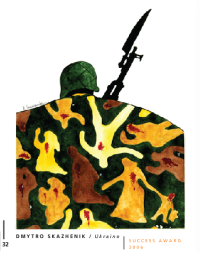 |
| Cartoon by Dmytro Skazhenik (Ukraine) was featured in Aydin Dogan Foundation’s "CUTTING EDGES: Cartoon Art Defining the World." |
By the time you read this, the Aydin Dogan Foundation’s impressive exhibition of prize-winning cartoons from all over the world will have run its course. The Foundation is Istanbul-based, & its cartoon-contest has been held annually since 1983.
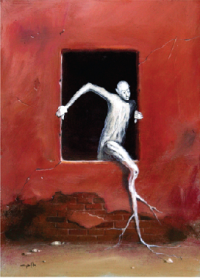 |
| Cartoon by Alessandro Gatto (Italy), featured in Aydin Dogan Foundation’s "CUTTING EDGES: Cartoon Art Defining the World." |
The announced & clearly perceptible purpose of the competition is to stimulate thinking about important issues among nations, not least the need for Peace & Understanding. Unlike the witty cartoons in The New Yorker, these often ingenious—even mordantly hilarious—drawings do not need captions to communicate their striking visual-messages.
Every year, 3,000 cartoons are submitted, 300 of which are submitted to an International Jury. More than 7,200 artists from 128 nations have competed thus far!
Not all cartoons on view were concerned with World Affairs. Some dealt more personally with Hope, Love, & Despair.
How about a Modern Submarine, powered by Roman-Galley oars? Or a carefree smoker leaning out a window in a huge clock-face, unaware that the hour-hand is about to decapitate him at 3 o’clock?
Or hordes of black submarines stranded on an empty beach like dead whales? Or a Fascist General sniffing a line of gunpowder from a shell, just like a line of cocaine?
Or a Human-Brain, equipped with a pistol-grip & trigger at its base? Or Military-Interrogators beating a bound-prisoner with bunches of flowers? Well, you get the Idea…
If you missed this fine if short-lived exhibition, all the prize-winning cartoons are included in full color in the catalogue, bearing the same title as the show: CUTTING EDGES: Cartoon Art Defining the World.
This has been published in Istanbul by the Dogan Foundation, but copies should be available by contacting the show-venue, the Society of Illustrators, at the address & phone-number noted above. If you want to enter a cartoon of your own, they will be able to tell you where & when to send it in!
At the Whitney Museum of American Art:
[945 Madison Avenue @75th Street/NY, NY 10021/Phone: 800-WHITNEY]
KARA WALKER: My Complement, My Enemy, My Oppressor, My Love
[Closing 3 February 2008]
This powerful visual exploration of conflicted narrative-visions of the History of Slavery in the South, of widespread if suppressed American Racism, of Sexually-Inflected Black/White fantasies, and much, much more is the first full-scale retrospective of the highly-charged imagery of Kara Walker.
Known widely for her ingenious adaptation of cut-out black-on-white Silhouettes, Walker’s strong satires in other media, such as small-scale water-colors, sketches & collages, are also highlighted in this important show which originated at the Walker Art Gallery in Minneapolis.
There are several large-scale room-filling black-on-white Silhouette-Panoramas that draw on the stereotypes of the mid-19th Century Blackface Minstrel-Show, as well as on such novels as Harriett Beecher Stowe’s Uncle Tom’s Cabin & Thomas Dixon’s The Clansman.
There are evocations of Kara Walker’s satirical use of shadow-puppets—also a form of Silhouette—carrying over into her more recent video-art. Even the short texts she has typed on filing-cards communicate sharply ironic—even hysteric—comments on the fact & act of Negritude, a label she does not, in fact, employ.
Not only the brutality of the lives of Plantation Slaves is on view, but also the sexual humiliations & perverted desires of White Slave-owners are intertwined. Curious Anal Sexual Fantasies are even evoked, as the Romance of the Old South is conflated with Abolitionist & Black visions of the reality of Slavery.
This fascinating show—which has already traveled from Minnesota to Paris—will also be seen in LA, at the UCLA Hammer Museum.
It is divided into a series of Narratives: Silhouettes, An Historical Romance, Uncle Tom, Negress Notes, African-America, Censorship?, & Retelling History.
Born in Stockton—in a fairly race-indifferent California—Kara Walker experienced the sudden shock of being really Black among racist Whites when the family moved to Georgia. There is a lot of understandable anger, hatred, & desire for revenge visible in some of her more unsubtle satiric cartoons.
[Incidental-Intelligence: Although use of the black cut-out paper-portraits date back to the French Court of Catherine de Medici in the late 16th Century, they are actually named for Etienne de Silhouette—Finance-Minister of King Louis XV—who made them as a hobby.]
Exploring History & Artifacts in Madison, NJ:
On a rare Stateside-Outing away from the Elitist-Shrines of Manhattan, Your Scribe recently visited the Madison campus of Drew University, a sanctuary of Methodism—with tuition higher than that at NYU. Souvenirs & reminders of Methodism’s Founders, John & Charles Wesley, abound, as do those of its early Circuit-Riding Ministers in America.
Possibly only Savannah [GA] has more Wesley-Memorabilia, for that is the only Landfall in the New World made by a Wesley. But John Wesley had come to Georgia as an Anglican pastor & a missionary to the Indians, not yet a Methodist.
Not so incidentally, this year marks the Tercentenary of Charles Wesley’s birth!
The Drew University Library has, among other treasures, a Georges Simenon Collection, currently celebrated with a major exhibit, opened by his son, John Simenon. There is also a Willa Cather Collection, as well as the Dornan Russian Samizdat Archive.
Both the Drew Library & Savannah’s Georgia Historical Society have small Staffordshire busts of John Wesley, but only the Drew has Henry Holiday’s magnificent 1890 stained-glass Rose-Window, centered on the mythical figure of Theology.
This crowned & haloed Goddess is surrounded by a ring of symbolic haloed Ladies, representing such virtues as Humility, Faith, Charity, & Hope. Philosphy, History, Science & the Arts are also included, for good measure.
[Of course, if you believe in Intelligent-Design, you will realize that Science is unnecessary, Faith being entirely sufficient for your Salvation. That is not, however, a Methodist-Doctrine.]
In Madison itself, there are a number of historic buildings & façades from the late 19th Century worth studying. One of the most interesting was dedicated on Memorial Day of 1900. This is the James Library, the first free public-library in Madison, before Andrew Carnegie began funding free libraries.
Outside it looks at first like one of Madison’s handsome stone churches, but its Henry Richardson-inspired Romanesque architecture was clearly secular in intent. The impressive structure is now the Museum of Early Trades & Crafts, with tools & artifacts offering metaphoric windows onto the Past of New Jerseyans in the 18th & 19th Centuries.
There are over 8,000 artifacts in its collections, but the building itself—its exterior & interior structures & ornamentation—is also a major-exhibit. On a recent Sunday, a large group of photographers descended on the museum, lensing every inch.
Across the street is a late Victorian building crested with gargoyles. The museum also has a gargoyle in its garden, but—even better than that—it has Stone Gargoyle Carving Workshops, led by Franco Minervini, one of New Jersey’s few surviving stone-cutters!
The most distinctive decorations in the former Library are handsome stained-glass panels, featuring symbolic images & inscribed with pithy mottoes to inspire readers young & old. Among the more resonant are the following:
Architecture is frozen Music. —FWJ von Schelling.
The Pen is mightier than the Sword. —Edward Bulwer-Lytton, bart.
Art is long & Time is fleeting. —Henry Wadsworth Longfellow [from the Latin: Ars longa vita brevis est.]
Never leave that till tomorrow which you can do today. —Benjamin Franklin.
Order is Heaven’s First Law. —Alexander Pope
Science is Organized Knowledge. —Herbert Spencer.
Education is our only Political Safety. —Horace Mann.
Nature is the Art of God. —Sir Thomas Browne.
Copyright © Glenn Loney 2007. No re-publication or broadcast use without proper credit of authorship. Suggested credit line: "Glenn Loney, Curator's Choice." Reproduction rights please contact: jslaff@nymuseums.com.